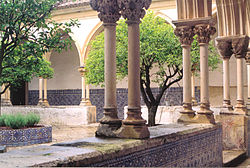This article needs additional citations for verification .(April 2025) |
| Part of a series on the |
| Knights Templar |
|---|
 |
| Poor Fellow-Soldiers of Christ and of the Temple of Solomon |
| Overview |
| Councils |
| Papal bulls |
|
| Locations |
| Successors |
| Cultural references |
| See also |
| |
With their military mission and extensive financial resources, the Knights Templar funded a large number of building projects around Europe and the Holy Land, many structures remain standing today. [1]





